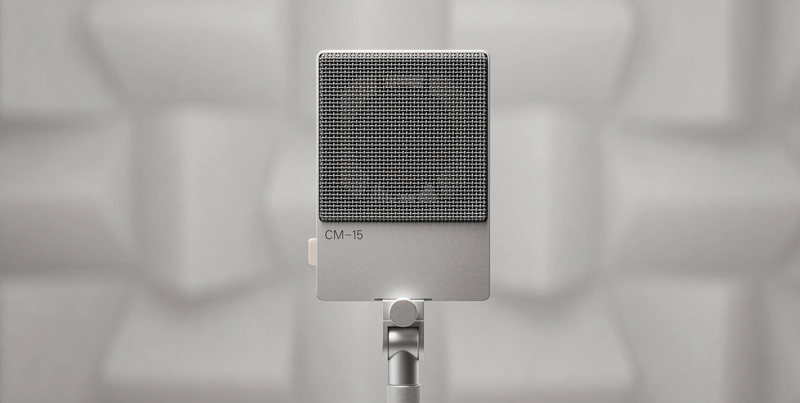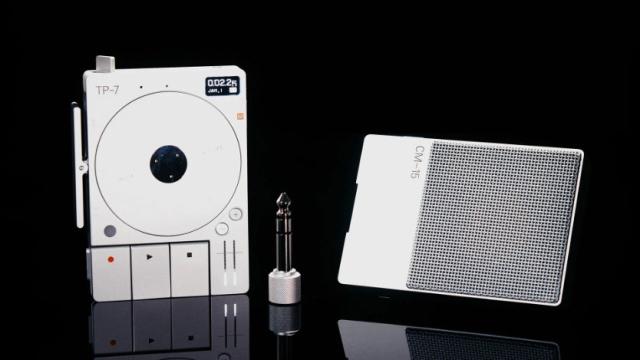This year, Swedish electronics manufacturer Teenage Engineering launched two new devices: a microphone, the CM-15, and a digital tape recorder, the TP-7. If purchased together, they’ll run you almost $US3,000. For many, it seems absurd to pay that much for products with features that come built into your iPhone — but they’re part of a radical mission. Teenage Engineering hasn’t given up on the idea that our devices should be cool, and if you can afford them, its products will bring you back to the era when buying new electronics felt experimental and fun. I spent the last few weeks playing with Teenage Engineering’s latest recording gear, and I haven’t had this much fun with gadgets in years.
The mic and the recorder round out Teenage Engineer’s Field series, a group of four products that also includes the TX-6 mixing board and a follow-up to the company’s iconic synthesizer, the OP-1 Field. Each is a compact portable device that functions on its own, but they’re built to work as a suite of interoperable tools that give you near professional-level capabilities when you’re away from home.
They’re jealousy-inducing products, and after a few weeks with them, I can tell you they’re as fun to use as they are to look at. Here’s our review of The CM-15 Field Microphone and TP-7 Field Recorder.
The TP-7 Field Recorder is as simple or multifunctional as you need it to be.
The first thing you’ll notice about Teenage Engineering’s $US1,499 tape audio recorder is the wheel. The TP-7 is modeled after a reel-to-reel tape recorder. It’s built around a physical, motorized disk that spins as it records or plays back sound. Check out the video above to see it in action. It’s like an old-school iPod, but much, much cooler. You can use the wheel to scrub through recordings, pause while you’re capturing audio, or move through the device’s menus. In a world where everything is a touch screen, it’s undeniably satisfying to use.
The TP-7 has a microphone, a speaker, three 3.5 mm jacks that work for both input and output, and a USB-C port to charge the device, transfer files, or plug in external mics (including the CM-15). It has a brushed steel case that will remind you of Apple products, but the orange leather you’ll find on the back of the device gives it a more premium aesthetic than anything you’ll get out of Cupertino. The TP-7 keeps with the analog theme of its spinning wheel with mechanical buttons and a physical rocker on the side; hold down the paddles, and it will rewind or fast forward, spinning the wheel in real-time. Every detail is well-considered; even the 1/4-inch headphone adapter it comes with is gorgeous.

I’ve used a lot of little audio recorders over the years, and the sound quality you get from the TP-7. I put it down in the middle of a small studio with a full band playing blisteringly loud. I listened back on the way home, and I could hear the isolated nuances of each individual instrument. Even when you’re just using the TP-7’s tiny built-in mic, its recording capabilities are stunning
As satisfying as the TP-7 is for music, it’s built with conversations in mind. Essentially, it’s a fancy dictaphone. The TP-7 comes with an iPhone app that transcribes spoken word recordings free of charge. I do a lot of interviews for work, so I’ve tried using it as my main recording device. You can pull it out of a pocket and take a voice note with the press of a single button, but I’ve also used it for more complicated recording setups. It works as its own mobile podcasting rig thanks to the fact that you can record from up to four audio sources at the same time. You can even do overdubs and set levels for individual tracks. At any given moment, the TP-7 is as simple or multifunctional as you need it to be.
My only gripe is transferring files is a bit more complicated than it should be. When you plug it into a computer, you expect it to work like a hard drive, allowing you to easily drag and drop files. It does, but you have to download a piece of software to make it run, which is a little annoying. On the other hand, moving files around over Bluetooth with your iPhone is relatively simple.
Do you need a $US1,499 tape recorder? Of course not. I’ve got a little Sony audio recorder I bought ten years ago for $US50, and it works just fine. On the other hand, you don’t need a Ferrari to drive to work every day, but it sure would be nice. The TP-7 feels great in the hand, it’s useful, and it sounds amazing. It also makes for a great party trick. I can’t tell you how much fun I’ve had showing it off to friends. If you’re the kind of person who can justify its price tag, the TP-7 is almost guaranteed to bring joy to your life. It’s available for pre-order, but the company hasn’t announced when the TP-7 is expected to ship.
The CM-15 Field made me sound like an angel.

I nerd out on audio gear. I’ve been a musician since I was a kid, and I’ve spent a lot of time doing podcasts in my professional life. As much as I love recording equipment, I generally don’t think of a microphone as a fun product. The CM-15 changed that.
The CM-15 packs just about every feature you could possibly want in a microphone into a tiny, beautiful little box. It’s a condenser microphone, which means you need an outside energy source to amplify the signal before you record it, known as “phantom power.” Typically, you get that from the recording interface, but the CM-15 also has phantom power built-in thanks to a rechargeable, 10-hour battery. That makes it even more useful for recording on-the-go
You also have a number of options to send the sound out of the microphone. It plugs in over a mini-XLR, USB-C, or 3.5 mm jack. It’s just as happy working with a mixing board, a portable recorder like the TP-7, or plugging into your phone or computer. I’ve been using it on video calls, and I’m told I sound like an angel. It even has a little built-in kickstand so you can prop it up on a desk, but it comes with an adapter for a mic stand if you want to get serious. It also has a switch on the back for three different gain stages, which is great for quick adjustments.
Like the TP-7 and every other Teenage Engineering product I’ve tried, the CM-15 sounds fantastic. I experimented with a number of different recording tasks. I compared it to a couple of other microphones — including a Shure SM57, a Shure SM7b, and an Audio Technica AT4050 — for a variety of different tasks from recording guitar to capturing voices in a studio for a podcast. At every turn, it either sounded better or offered an appealing alternative.
Again, the CM-15 left me hunting for anything negative to say. The only flaw I could come up with was it didn’t work right out of the box with older iPhones, but with an iPhone 14 or 15, the mic was plug-and-play. Even then, the CM-15 isn’t marketed as a mic for your cell phone, so it’s hardly a criticism.
The only real complaint is the price tag: $US1,200. That’s a lot of money for a mic, even one that sounds great. For the money, you could buy yourself an outstanding studio-level microphone and still have plenty of cash left over to pick up a dedicated mic for your Zoom calls. That doesn’t shake my aching desire to buy one for myself.
The Bottom Line
The minute I got my hands on the TP-7 and the CM-15, I was charmed. After weeks of making them part of my daily routine, that initial impression held up. They’re almost perfect. I’ve got more serious audio equipment, but time and again, I found myself reaching for these little gadgets.
The other day, I was talking to a friend about the TP-7 and he said, “I wish I was in the target audience for these things.” The prices mean they’re reserved for a very specific subset of consumers with a lot of disposable income. On the surface, the costs are unjustifiable. There are less expensive products with fuller feature sets that perform just as well. But you aren’t just paying for a mic or a recorder with these devices, you’re shelling out for a premium experience, and to some extent, you’re buying into a lifestyle. On that front, the TP-7 and CM-15 deliver. These gadgets aren’t for everyone, but if they’re for you, you’re probably going to love them.
